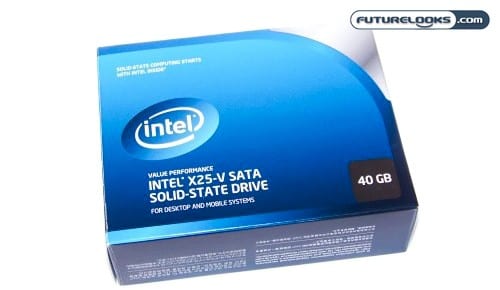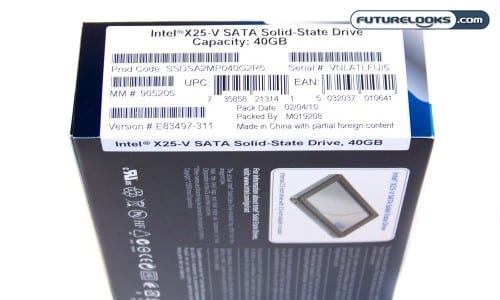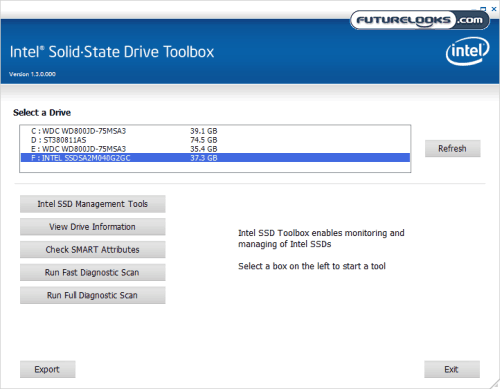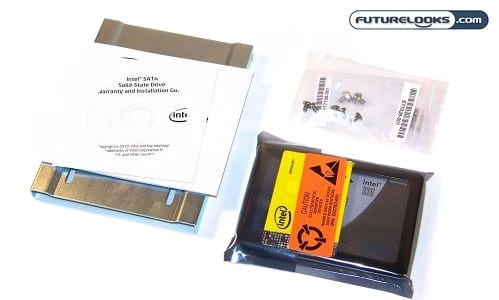
While SSDs are still a fairly new technology, it has certainly come a long way in the last couple of years. The choices in SSDs are increasing and the prices are also decreasing making it possible to own one without a second mortgage. Though SSDs are getting cheaper, they still aren’t cheap, with larger ones still hitting some heavy figures. But even a smaller drive can make your system faster and INTEL has responded with the introduction of their 40GB Value Performance X25-V SATA Solid-State Drive (SSD).
One of the methods that people have used to get the best of both worlds with SSDs is by purchasing a smaller and cheaper SSD to use as a boot drive. By installing the OS onto the drive, you get the blazing fast start up times that SSDs are known for while packing all your other files or large programs onto a hard drive. INTEL has recognized this type of usage and have answered with their new X25-V that we’ll be checking out for you today. Let’s find out how this drive performs against other boot drive worthy competitors.
Features and Specifications

Intel SSDs are renowned for having very efficient and capable controllers. Even though this is a 40GB Value model, it still comes packed with performance intended to improve your desktop experience. That means, you can expect quicker boot and program access times you don’t get with conventional platter drives. Inside the 40GB SSD is some of best 34nm NAND memory money can buy. It’s quality made NAND which means it can keep with most demanding systems limiting any wear leveling effects that you probably won’t see for around 10 years. Will you still have this SSD then? We think not. However, it’s nice to know that it’s built to go the extra mile.

All Intel SSDs offer features like Native Command Queuing (NCQ) enabling up to 32 concurrent operations, Intel SSD Toolbox, and Intel SSD Optimizer. Of course, Trim support is also included as part of this deal, which helps SSDs maintain their performance and longevity. Toolbox naturally contains the diagnostic tools for managing your SSD. Optimizer uses ATA Data Set Management Command (Trim Attribute) that keep it tuned up for that “fresh out of the box” performance you experienced from day one.
What’s in the Box?

Retail SSD kits are worth the extra $5 over the price of an OEM version. The main reason is because of the extras that you get which include mounting screws as well as the SSD drive bay plate. We’ve seen several different mounting kits out there, from very cheap looking brass brackets, to more stylized black mounting plates from the likes of Patriot Memory. Intel has also decided to do something a bit different, giving you a brackets with enough holes to line it up with any number of cases on the market, right inside a standard 3.5 inch bay.
If you don’t have a network connection in your new system to download the Intel SSD software, it’s also included on one of the discs as part of the retail box experience. Keep in mind that the software is always being updated and it’s a good idea to keep an eye on Intel’s download page every few months for the latest version.
Test Setup
First off, you should know that most any computer system that supports SATAII can also support an SSD. If you run into issues, a quick mainboard BIOS update can usually help. If not, you can always find a capable SATAII controller card for reasonable prices rather than completely upgrading your entire system. We didn’t experience any issues with our installation using our chosen test system which is fairly new.
Here’s the break down list of the test system:
- Intel Core i7-870 “Lynnfield” Processor
- GIGABYTE GA-P55A-UD6 Motherboard
- Kingston HyperX 16GB 1600MHz DDR3 Memory
- ZOTAC Geforce 9800GT 512MB Graphics Card
- HHD 1: Seagate Barracuda 7200.11 80GB Hard Drive
- SSD 1: Intel X25-V 40GB (Our specimen)
- SSD 2: Kingston SSDNow 40GB V+
- SSD 3: OCZ 60GB Agility
- Antec TPQ-1000 Watt Power Supply
- Windows 7 Ultimate 64-bit
- CPU cooled by: Zalman CNPS10X Extreme
As with all our tests, we use the latest BIOS and drivers available at the time of publishing. One thing we’d like to point out is that the Kingston 40GB SSD contains a similar, if not the same, Intel controller and NAND memory. The main difference will be found in the firmware. We’ll definitely be looking at how these two drives compete against eachother.
Since this is a boot drive test, we’ve included the smallest capacity SSDs on hand. Naturally, the operating system, MS Office and necessary desktop software were installed to simulate a real world payload of software.
Benchmark Notes
To keep things simple and answer all the performance questions any potential user might have, we used SANDRA Physical Drive Benchmark, Crystal Disk Mark, QuickBench, and ATTO. With the exception of “seek” times, the higher the transfer rates and/or index, the better the drive.
As you will see from here on, there are trade offs to some boot drives based on their controllers. The Kingston 64GB V+ and OCZ 60GB Agility SSDs have controllers tuned for higher higher write speeds rather than read speeds. But, the basic boot drives are tuned for read speeds and lower, steadier write speeds. These boot drives will be just a bit quicker on the boot, hence the coined nick name. They also incidentally have lower price tags, allowing you to install one in tandem with a standard, but much larger, hard drive for the best of both worlds: storage and speed.
SiSoftware SANDRA
Here, we see the trade off in action between the two 40GB boot drives and two conventionally tuned SSDs. It would appear that Intel X25-V controller is better tuned for read and write performance than the Kingston. That’s roughly 30.8 MB/s quicker read speeds. Translated into the real world, that means that your system will boot faster and your programs will load even quicker.
Crystal Disk Mark 2.2
Crystal Disk Mark (CDM) gives us a more realistic look at the performance you can expect from an SSD. It’s also the reason why we choose to include it as a standard test in many of our other reviews including motherboards. For SSDs, one area of weakness is the small 4KB data block performance so keep an eye on that.
First, take a look at the 100MB performance. This is more indicative of the largest files we manage daily with our systems.
Next, here are the results for the larger file tests. Do you see the 4KB differences between the SSDs? Both 40GB drives basically double the two standard SSD’s 4KB performance which, as you know, makes up the bulk of the operating system’s building blocks. Thus, we get some quick boot performance all around. It’s the Intel SSD that shows the fastest read performance overall
QuickBench
Conceding to the fact that the V+ and Agility offer slower small block and higher large block performance, only the two 40GB SSDs are compared. It’s kind of a Kingston versus Intel SSD, even though they’re essentially the same inside. Their controller tuning is what we’re looking for in terms of block performance.
Again, we see the controllers giving us their best performance in the data block tests. The Intel SSD shows some better tuning slightly topping the Kingston SSD. Random rates show us that the controller is pretty much tapped out in this regard.
The Intel SSD offers similar sequential performance most likely due to its firmware. We also see that write speeds are locked at about 44 MB/s for both. Obviously, the V+ and Agility drives in previous benchmarks would easily top these two here.
HD Tach 8MB Test
One of nicest features Intel SSDs offer is their Toolkit and Optimizer software. It’s really easy to use as well as quite a small program. It’s suppose to do a really good job of managing any Intel SSD. To see if there are added benefits of using the software, HDTach was used to test the SSD while loaded down and then tested after using the software.
Performance isn’t all that bad with the SSD loaded down with about 18GB of random data. It took a long time to copy random data from a regular hard drive so that’s how much we believed in this benchmark.
After running Intel’s more efficient software utility, the average rates actually increased. Unfortunately, the Kingston SSD took a lot longer to manage itself requiring a few more hours before it was ready to run.
And, just so you know, the 32MB tests pushed both SSDs to their 43 to 45MB/s maximum average reads. The 8MB tests don’t load the controllers with enough sizable data at once. This is yet another reason why these boot drives make quick work of the typical desktop duties such as firing up programs and of course, booting into the OS very quickly.
Final Thoughts
If we learn anything from these benchmarks, it’s that buying an SSD with proper management software to maintain those “new SSD” performance levels is really a huge plus. Many SSDs rely on their own included self cleaning software to manage themselves, and while that’s a good thing, it’s just not as fast as a standalone application. It also means, you won’t see the benefits till after a good nights sleep which is usually when it’s doing its thing. Some of us just don’t have that kind of time to wait around for our performance. We want it now and that’s why we bought the SSD in the first place.
Ultimately, the Intel X25-V 40GB Solid State Drive is a surprisingly robust little tank. It’s well tuned, resilient to being loaded down, fast on the 4KB block draw and has Intel software support. Carrying a varying retail price tag of $99 to $120 shipped makes it an extremely competitively priced boot drive SSD. If only it came in a 60GB model with similar pricing, it would be the perfect size for being an everyday use drive that could carry most of your often used applications, and maybe even a couple of your favourite games too.
Pros:
- Intel SSD Toolkit and Optimizer
- Very fast read performance
- Impressive 4KB data block and boot performance
- Competitive retail pricing
Cons:
- Lower larger data block write speeds
- How about a bigger 60GB for the same price?
Overall Score: 9.0 / 10.0
Help Us Improve Our Reviews By Leaving a Comment Below!
